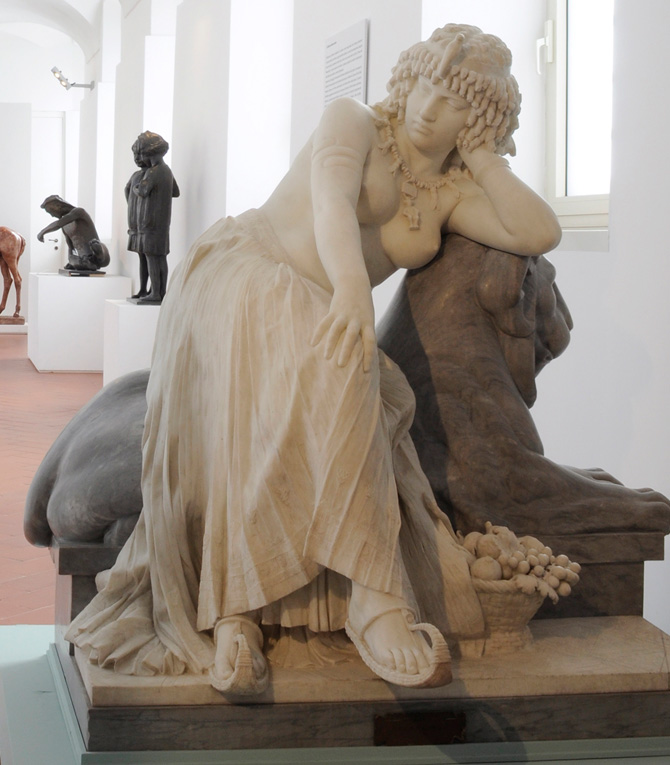Wusun rider 3rd-2nd C. BCE
"Wusun 烏孫 [wu = crow; black + sun = grandson. Wu-sun]. The Wusun, “M. ·ou-suən < *·aĥ-smən, a nomadic people north of the T’ien-shan in the Han period, are probably to be identified with the Άσμίραιοι [Asmiraioi] of Ptolemy.” Pulleyblank (1963), p. 136. Pulleyblank, ibid. p. 227 says: “There is good reason to think that the Wu-sun spoke a Tocharian type of language.”
The Wusun were a semi-nomadic people who raised horses and grazed their flocks on the rich steppe-lands in the basins of the Ili, Naryn and Chu rivers in Semirechye to the north of the Tianshan ranges and around lake Issyk-kul. They were a large and powerful group; the Hanshu estimating their population as some 630,000, with 188,800 men able to bear arms (CICA, p. 143 and n. 376).
The Wusun became of great importance to the Chinese as soon as they began extending communications to the west during the Early Han Dynasty. The Wusun not only controlled the main northern branches of the Silk Routes, but also provided a buffer against the raids of the Xiongnu, and were an important source of horses.
The Chinese proceeded on a complex course of diplomacy and bribes to win their favour and prevent them falling into the arms of the Xiongnu. A princess was sent to marry their leader, the ‘Kunmi’ c. 110 BCE, but she had to take second place to the princess sent to the Kunmi (or Kunmo) by the Xiongnu. CICA, p. 148, n. 400.
Little is heard of them during the Later Han Dynasty and we find only occasional references in the Hou Hanshu. However, there is a rather telling remark in the Chapter on the Western Regions that following the re-establishment of Chinese control in the Tarim Basin in 127 CE, “the Wusun and the countries of the Congling 葱嶺 (Pamirs), put an end to their disruptions to communications to the west.”
The last reference to them in the Chinese histories is a report of an exchange of diplomatic missions in 436 CE. It is not clear what happened to them after this date. See: Zadneprovskiy (1994) pp. 459-4
The capital of the main branch of the Wusun, referred to as the ‘seat of the Greater Kunmi’ in the Hanshu, was named Chigu 赤谷; literally, ‘Red Valley’ [chi = ‘red’ + gu = ‘valley’. Ch’ih-ku]. This town has so far remained unidentified but I believe it is now possible to locate it with a fair degree of precision and certainty.
First, there is the name of the town, Chigu or ‘Red Valley.’ There is, in fact, a very dramatic and famous red-coloured mountain and valley not far west of the present town of Karaköl:
“About 25 km west of Karakol, at the mouth of the Jeti-öghüz canyon is an extraordinary formation of red sandstone cliffs that has become a kind of tourism trademark for Lake Issyk-Kul.
A village of the same name is just off the main around-the-lake road. Beyond it the earth erupts in red patches, and soon there appears a great splintered hill called Razbitoye Serdtse or Broken Heart. (Legend says two suitors spilled their blood in a fight for a beautiful woman; both died, and this rock is her broken heart.)
Beyond this on the west side of the road is the massive wall of Jeti-Öghüz. The name means Seven Bulls, and of course there is a story here too – of seven calves growing big and strong in the valley’s rich pastures. Erosion has meant that the bulls have multiplied. They are best viewed from a ridge to the east above the road. From that same ridge you can look east into Ushchelie Drakanov, the Valley of Dragons.
Below the wall of the Seven Bulls is one of Issyk-Kul’s surviving spas, the ageing Jeti-Öghüz Sanitorium, built in 1932 with a complex of several plain hotels, a hot pool, a restaurant and some woodland walks....
From here you can walk up the park-like lower canyon of the Jeti-Öghüz river to popular summer picnic spots. Some five km up, the valley opens out almost flat at Dolina Svetov, the Valley of flowers.... There are also said to be pre-Islamic petroglyphs up here, similar to those at Cholpon-Ata.” King, et al. (1996), p. 392.
As there are no other noteworthy red-coloured rock or cliff formations around Issyk-köl, it seems probable that Jeti-öghüz is identical to the ‘Red Valley’ and ‘Red Mountain’ of the early Chinese accounts. This is confirmed by the distances contained in the Hanshu between Chigu and the town of Wensu, to the south of the mountains.
The Hanshu (CICA: 162) gives the distance from Wensu to Chigu as 610 li (254 km). Wensu, was located in the valley of the Dashigan He (also known as the Taushkan Darya), and is usually identified with the region of modern Wushi (Uch Turfan or Urqtur pan), about 85 km west of Aksu (see note 21.7 below).
My measurements range from 230 to 270 km from the Jeti-Öghüz Sanatorium, over the relatively low (4,284 m or 14,055 ft) Bedel Pass to the town of Wushi, depending which of several possible routes are chosen through the mountains. (Checked on Russian Military 1:100,000 topographic maps, 1970 and 1973, and the U.S. Defence Mapping Agency Aerospace Center map ONC6, Sheet F6, 1:1,000,000, revised Feb. 1981). This confirms the likelihood that Chigu was located somewhere in the upper Jeti-Öghüz Valley.
Notes on Bedel Pass adapted from Merzliakova (2003): “In ancient times the Middle branch of the Silk Route went from Chaogan to Kashgar, then Aksu over the Bedel Pass toward Issyk-Kul. Further two branches of the Silk route went from the Pass along the Southern and Northern side of the Issyk-Kul.” “This is the most convenient Pass to the North of Kashgar.”
-Notes to The Western Regions according to the Hou Hanshu. Second Edition (Extensively Revised and Expanded). John E. Hill. University of Washington.
_Kazakhstan.jpg)


Comments
Post a Comment